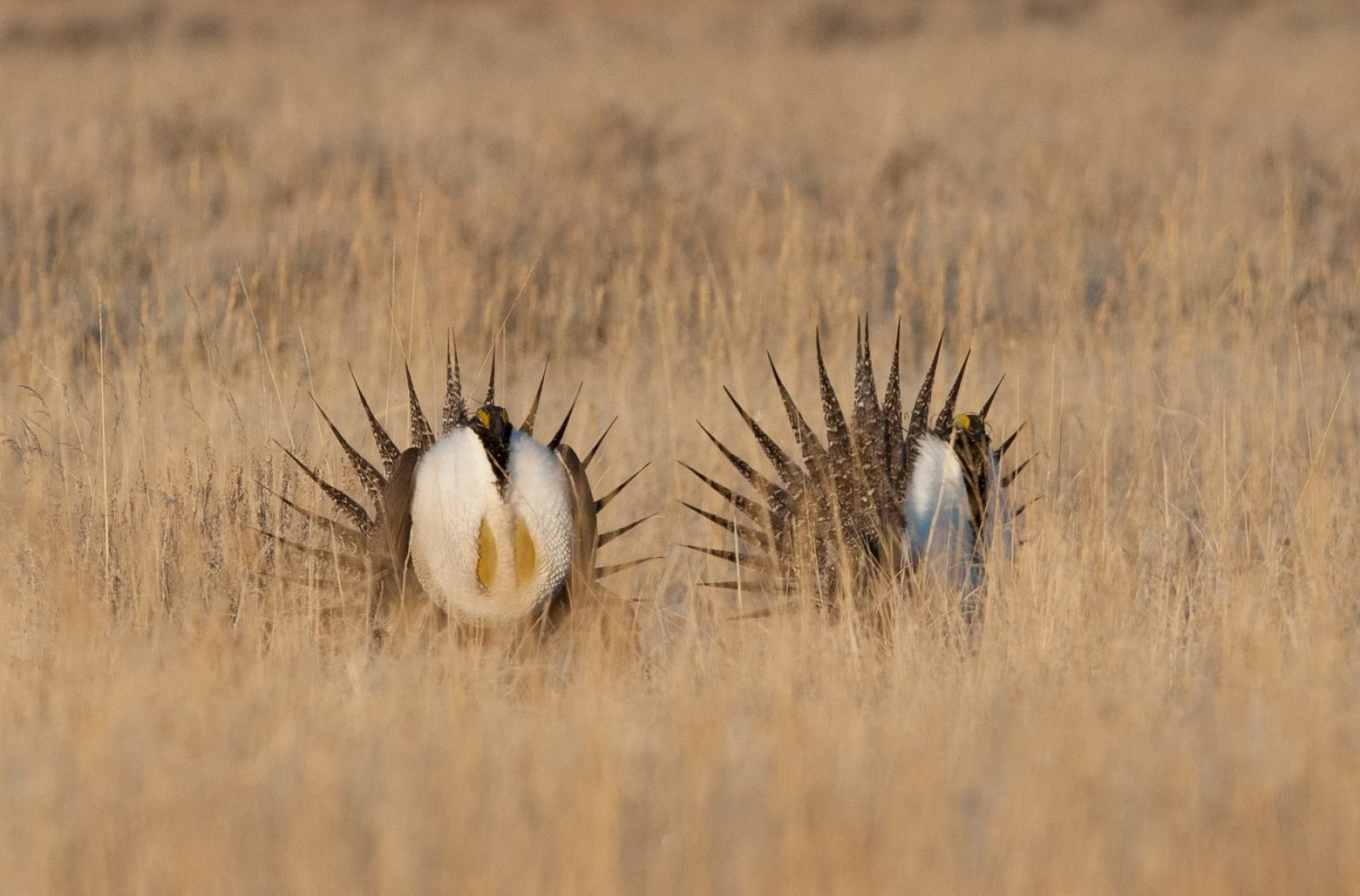[et_pb_section bb_built=”1″][et_pb_row][et_pb_column type=”4_4″][et_pb_text _builder_version=”3.10″]
We need your help to protect the Greater sage-grouse from a political effort to weaken the Wyoming-led plan that helped avoid an endangered species listing of the iconic western bird. You can help by submitting comments to the Bureau of Land Management by August 2, 2018.
BACKGROUND—
The BLM’s Wyoming State Office is accepting written comments from the public on its draft plan to amend a multi-year planning effort finalized in 2015 to conserve the species. The Trump administration wants to re-do the plans to give greater weight to state and industry concerns. This is unnecessary and risky. Although the draft plan for Wyoming contains many of the essential features of the 2015 plan, it also removes key elements that biologists believe are necessary to avoid the need for listing the species as threatened or endangered under the Endangered Species Act.
POINTS TO CONSIDER IN YOUR LETTER —
- Tell the BLM to keep the 2015 Greater sage-grouse conservation plans in place. These plans — covering all of the western states where sage-grouse are found — were the result of years of scientific study and collaborative efforts in Wyoming and in the other western states, and the deal should be honored. Any changes or “tweaks” that experts deem necessary can be accomplished through minor plan amendments, or so-called maintenance actions. A complete rewrite is an unnecessary waste of federal resources, and risks upending the official finding made by the U.S. Fish and Wildlife Service that a listing under the ESA is not needed. The certainty provided by the 2015 plans is now being called into question as changes to the plans are proposed based on political, rather than scientific, considerations.
- Tell the BLM that a state-by-state approach to conserving the Greater sage-grouse is counter productive. The Greater sage-grouse is a landscape scale species that needs expansive, undisturbed tracts of intact sagebrush habitat to survive. The 2015 plans recognized this, and contain science-based conservation measures that applied uniformly across the species’ range. The proposed state-by-state plan amendments will lead to a patchwork of efforts, some with sound conservation measures (like Wyoming) and others with wholly inadequate measures. Will Wyoming be left “holding the bag” because other states have failed to develop adequate conservation strategies? A landscape-scale approach with all states participating in good faith is the best way to ensure effective conservation of the species.
- The plans proposed by BLM must do a better job of protecting core population areas, also known as Priority Habitat Management Areas, by reducing the main threat to Greater sage-grouse: oil and gas development. Tell the BLM to make core population areas off limits to new oil and gas leasing. Development on existing leases should be managed under strict regulations now in place that limit surface occupancy and disturbance, but new leasing that would allow for even more development should be prohibited. More energy development in the bird’s most important habitat will not help conserve the species.
- The BLM’s proposal strips the fundamental mitigation goal of “net conservation gain” from the plans. Tell the BLM that a no net loss of habitat that merely prevents additional habitat loss (i.e., stops the bleeding) is not adequate to conserve the Greater sage-grouse. The science shows that the plans must achieve a net conservation gain if the species is to stand any chance of long-term recovery.
- The BLM should improve plan monitoring and oversight, and must do a much better job following its plans. Our experience over the past several years has revealed that the BLM routinely failed to follow its own 2015 plan, largely because BLM failed to provide training to field staff and the necessary incentives to ensure proper implementation. The best plan in the world is worthless if agency personnel fail to enforce it. The plan should contain metrics by which conservation success can be measured — statements that the plan is working without objective evidence to support those claims will not be sufficient to convince the USFWS that the plans are effective conservation tools.
- Tell the BLM that the proposed plan does not provide for adequate openness and transparency of important planning decisions. For example, the BLM would like to be able to modify habitat designations (e.g., core vs non-core) via an internal process, rather than going through a formal plan amendment. Tell the BLM to follow its own regulations and use an open process to make important changes to the plan. The public should have a say in how public lands and wildlife are managed.
NOW, TAKE ACTION —
You may submit comments by U.S. mail to the Wyoming BLM state office.
Mail your letter to:
Mary Jo Rugwell
State Director
BLM Wyoming State Office
5353 Yellowstone Road
Cheyenne, WY 82009
(Be sure to include “attn: Greater Sage-Grouse EIS.”)
Alternatively, you may submit comments via email to:
Jennifer Fleuret McConchie
Planning and Environmental Coordinator
Bureau of Land Management
Wyoming State Office
(Be sure to include “attn: Greater Sage-Grouse EIS” in the subject line)
[/et_pb_text][et_pb_button admin_label=”Email the BLM Button” _builder_version=”3.9″ button_text=”Email the BLM” button_url=”http://www.congressweb.com/WYOC/40″ url_new_window=”on” button_alignment=”center” /][et_pb_text _builder_version=”3.9″]
Please personalize your letter. We are witnessing an alarming trend in federal agency decision-making that discounts comments that appear to be based on “form letters.” Your letter will be given greater weight if it contains specific comments that relate to your experiences concerning sage-grouse. For example, if you enjoy watching the males engaging in the flamboyant mating display on leks, or hope to do so in the future, please consider including that bit of information in your letter.
Click this link for additional information related to the BLM planning process.
Thank you for speaking up for Wyoming’s amazing Greater sage-grouse!
[/et_pb_text][/et_pb_column][/et_pb_row][/et_pb_section]

